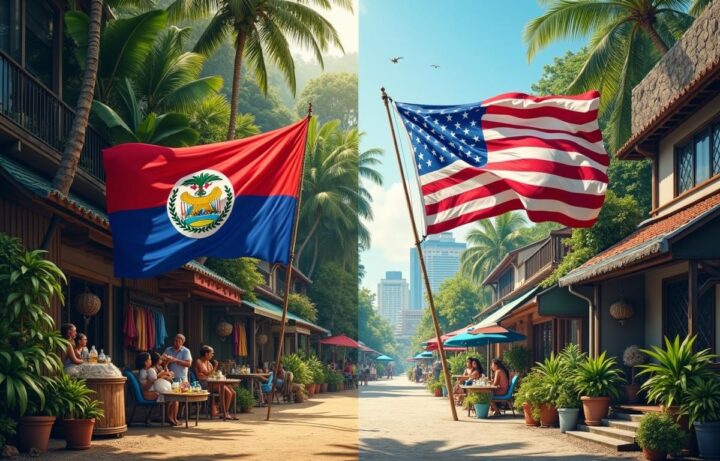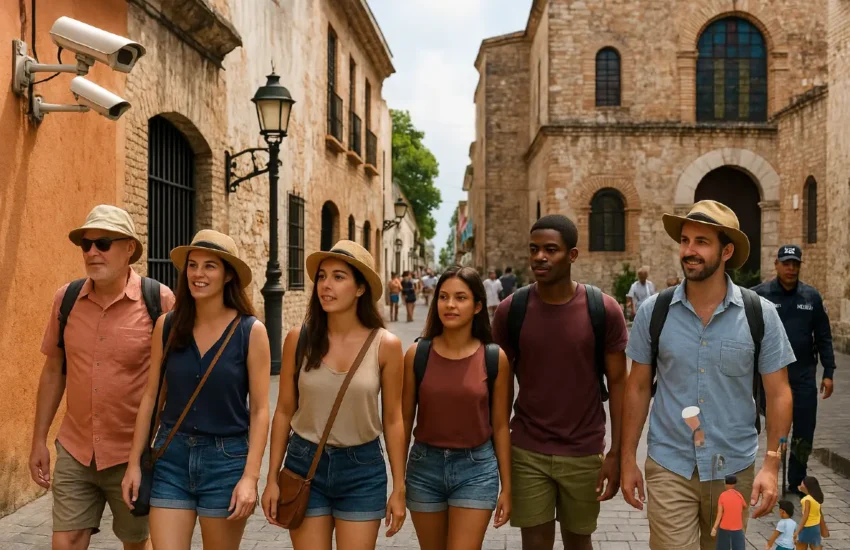Why Cost of Living in Belize is so Reasonable
The cost of living in Belize shows a striking difference compared to Western countries. Expenses run about 50% lower than in the USA, making Belize an appealing choice to retire or relocate. Local Belizean households earn around $700 monthly. A couple who moves there can live well on $1,500 to $2,000 per month.

The exact living costs in Belize paint an interesting picture. A single person needs roughly $768 monthly without rent. A family’s expenses reach about $2,705 for the same items. On top of that, the cost gap between Belize and the US becomes clear through real examples. Inland apartments with two bedrooms rent for as low as $600 monthly. Beachfront properties start at $1,200. Belize’s cost structure has some surprises – meals out cost $15-25, but utilities cost more than America at $0.22 per kWh. This Caribbean paradise offers better value than Nicaragua, Costa Rica, or Panama, especially when you have retirement plans and want your budget to go further.
Cost of Living in Belize: A Real Month for a Single Person
A month of living in Belize shows what a single person really spends there. The daily costs paint a better picture than vacation expenses when you’re planning a long-term stay. Let’s look at the real-life numbers you might need to budget as a solo resident in this tropical paradise.
Housing Costs for a Single Person
Location plays a big role in finding affordable housing in Belize. You can rent a one-bedroom apartment in Belize City for about $275 per month, which costs way less than similar places in the United States. Beach living will cost you more. An apartment on Ambergris Caye runs about $516 monthly, while coastal properties in Placencia and Hopkins start at $1,200 for a one-bedroom unit.
The inland areas offer better deals. San Ignacio has two-bedroom homes available for just $600 monthly. Many expats buy property instead of renting, especially in areas like Cayo where homes cost less than $150,000.
Food and Grocery Expenses
Your eating habits determine how much you’ll spend on food in Belize. Shopping like a local can save you money. Simple grocery items cost around $0.60 for flour, $0.50 for rice, and $0.80 per pound for sugar. Whole chicken costs about $1.25 per pound, and local fish filets go for around $8 per pound.
A couple typically spends $400-$600 on food each month, so a single person can get by on $175-$250. Imported foods can really add up – items like ranch dressing ($21), Oreos ($15), or Gray Poupon mustard ($54) will make your grocery bill jump.
Transportation and Getting Around
Public transport keeps travel costs down in Belize. A one-way ticket costs $1.75, and monthly passes run about $21.20. Taxi fares start at $3.48 with a per-kilometer rate of $3.97.
Gas prices sit at $6.50 per gallon if you want your own car – that’s double the US price. Car insurance runs about $250 yearly, and vehicle licensing costs $100 per year. Many people living on islands or near the coast use golf carts instead, which make more sense and cost less.
Utilities and Internet Bills
Utilities take up much of your budget in Belize. Electric rates run high at $0.22 per kWh for homes. A couple using AC moderately might pay $150-$200 monthly, while those who stick to fans spend around $50.
Water bills stay reasonable at $20-$50 monthly. Internet packages cost from $25 for 20Mbps to $100 for 150Mbps service. Cell phone plans with unlimited talk, text, and 8GB of data cost about $28 monthly.
Entertainment and Leisure Activities
Entertainment costs depend on what you like to do. Tourist activities like snorkeling tours ($65-$100), scuba diving ($35 for popular trips), and cultural experiences are occasional treats rather than regular expenses for residents.
Local fun costs less for everyday life. Local restaurants charge $6-$10 per meal, which beats tourist spots by a lot. A domestic beer costs $2-$3, making nights out cheaper than in Nicaragua or Panama.
The bottom line? A single person needs about $1,000-$1,500 monthly to live in Belize. Many future retirees find they can live well on $2,000-$2,500 per month, depending on their lifestyle and where they live. This budget lets you enjoy a good life while experiencing all the tropical pleasures that make Belize special.
Housing in Belize: What You Get for Your Money
Your biggest financial decision about moving to Belize will be choosing where to live. Living costs change based on whether you rent or buy, and if you want to be right on the beach or further inland. I’ve spent years in this tropical paradise and learned a lot about housing costs that could help you make the right choice.
Renting vs Buying a Home
Every expat faces the big question: should they rent or buy in Belize? Renting gives you more freedom and needs less money upfront. You’ll pay about $318 monthly for a one-bedroom apartment in the city center, while three bedrooms will cost around $737. The prices drop if you move away from city centers – one-bedrooms go for $226 and three-bedrooms for $449.
Buying comes with different math. A square meter in Belize City costs $989 in the center, but here’s the surprise – prices outside can jump to $2,583 per square meter. On Ambergris Caye, you’ll find condos average $463,252, with one-bedrooms starting at $290,027 and three-bedrooms reaching $766,915.
Most expats start by renting before they buy – a smart move given the local wisdom that says it’s “easy to buy, hard to sell” in Belize. This lets you try different areas first, just like someone might test out spots before picking their retirement home.
Living Near the Beach vs Inland
Where you live makes a huge difference in your costs. Beach properties cost more, and Ambergris Caye tops the list. Houses there average $938,068, starting at $640,569 for two bedrooms and going past $1.4 million for bigger homes.
Life inland costs way less. The Cayo District has homes from $150,000 to $547,500. These prices beat what you’d pay in Nicaragua or Costa Rica. People who don’t need ocean views get great value inland.
Corozal in the north offers good deals with homes starting at $100,000 to $150,000. The Placencia Peninsula runs from $199,000 to $895,000 for condos and $181,500 to $2,300,000 for houses. These prices match Panama but come with that special Caribbean feel.
Hidden Costs like Maintenance and Property Taxes
The purchase price isn’t everything in Belize. You need to know about other costs too. Property taxes stay low at 1.5% of the assessed value – usually just 10-30% of what it’s worth in the market. A fancy house might only need $100-$400 in yearly property taxes.
Buyers should plan for 1-2% in closing costs plus a government stamp duty – 5% for locals, 8% for foreigners. The first $10,000 doesn’t get taxed.
The tropical weather means you’ll spend money on upkeep. Beach homes need extra care because of humidity, salt air, and possible hurricanes. Wood doesn’t last as long here, which explains why everyone builds with concrete.
Bills add up too. Electricity runs about $0.45 per kWh. This costs more than North America. Two people using AC now and then might pay $150 monthly.
Building your own place costs $30-$60 per square foot. This works well if you have specific needs and time to watch over construction during your stays.
Make sure to check property titles carefully before buying. While Belize protects foreign owners’ rights, some scams exist. Good lawyers help protect your investment and make buying smoother.

Food Costs in Belize: Eating Local vs Imported Goods
Food shopping in Belize shows a stark reality about the cost of living. My time learning about local markets and grocery stores in the country has taught me that your food budget can swing wildly based on where you shop.
Shopping at Local Markets
The vibrant local markets paint the true picture of Belize’s cost of living. San Ignacio Market buzzes with life, especially on Saturdays. You can find affordable produce, local crafts, and fresh-cooked foods. Local fruits and vegetables cost much less than imported ones. A dollar gets you 7 bananas, while mangoes run $1-2 each when in season. Four oranges sell for just a buck.
Each location has its own market rhythm. Hopkins gets fresh produce deliveries on Tuesdays and Fridays from the Cayo region. Mennonite farmers bring their homemade cheeses and other goods to markets nationwide. Fish lovers can grab fresh filets in fishing villages like Hopkins for $5-10 per pound.
Eating Out at Local Spots vs Tourist Areas
Restaurant prices tell two different stories about Belize’s cost of living. Local spots are a great deal—you’ll pay around $4 for stew chicken with rice and beans. Street vendors sell tacos at $0.25 each and plantain chips for $0.50. Tourist restaurants charge $10-15 per person for regular meals, while fancy spots run $20-40.
Ambergris Caye’s happy hours make drinks affordable. Local rum and beer cost $2-3, but wine and imported beers will set you back quite a bit. This price pattern runs through all of Belize, making restaurants about 49% cheaper than US prices overall.
How to Save Money on Groceries Each Month
Smart grocery shopping in Belize starts with local products. Rice runs about $1.50 per pound, same for flour, while sugar costs $0.50-1.00. Local brands save you money—Caribbean Pride juice at $6.50 beats imported juice at $18.
Imported items come with eye-popping price tags: $21 for ranch dressing, $41 for sundried tomatoes, and $15 for Oreos. Watch those expiration dates on dairy products since refrigeration can be spotty.
One person planning retirement can keep monthly grocery costs between $175-250 with smart shopping. Belize’s food costs match Nicaragua and Costa Rica when you stick to local foods. Panama might offer similar value, though each country’s food scene stands unique.
Your food budget stretches further when you shop at local spots, buy seasonal produce, and visit different vendors.
Transportation and Utilities: Managing Monthly Expenses
Transportation and utilities make up much of Belize’s living costs. Your lifestyle choices can impact your monthly budget drastically.
Owning a Car vs Using Public Transport
Belize’s transportation options create an interesting cost dilemma. A vehicle needs substantial investment – third-party insurance costs about $250 per year, vehicle licenses cost $100 yearly, and driver’s licenses run $30 annually. The country’s unpaved roads cause heavy wear and tear on vehicles.
Public transport offers a budget-friendly option to anyone who wants to retire here. American school busses, now painted in bright colors, run on the main highways across the country. You’ll pay just $7 for a bus ticket from Belize City to San Ignacio, and $3 from Belmopan to San Ignacio. Island residents use golf carts ($15-25 daily) and bicycles as their main way to get around. This cuts down living costs by a lot compared to Nicaragua.
Gas Prices and Taxi Fares
Gas prices are a key factor when comparing Belize’s living costs to the US. A gallon costs between $5-7, almost twice the American rates. Recent price hikes saw regular gas jump twenty-three cents while diesel went up thirty cents in one day.
Taxis, which you can spot by their green plates, charge fixed rates instead of using meters. Local rides cost $5-10, and airport taxis to Belize City charge a flat $25. Longer trips between cities usually run $60-100, which matches Costa Rica’s living costs.
Electricity, Water, and Internet Costs Explained
Utility costs in Belize can surprise you. Power rates are quite high at $0.22-0.45 per kilowatt-hour. Two people using moderate air conditioning might see bills of $100-250 monthly, while those who skip A/C might pay just $50.
Water bills stay reasonable at $20-25 monthly. Internet service ranges from $25 for simple 20Mbps connections to $80 for faster 150Mbps speeds. Cell phone plans with 8GB data and unlimited talk and text cost around $28 monthly. This makes staying connected affordable even for month-long stays.
Living in Belize needs careful planning, as with Panama, though Belize’s utility costs – especially electricity – run higher than other Central American spots.

Cost of Living in Belize vs US and Other Countries
The cost of living in Belize tells an interesting story compared to other countries. My experience living in several Central American countries has taught me exactly how far your money goes. Let me share some real numbers that will help you plan better.
Cost of living in Belize vs US breakdown
Life in Belize costs less than the United States in most categories. The latest data shows Belize is 33.7% cheaper than the US without rent. This difference becomes even more dramatic—46.7% lower—when you add housing costs. You’ll pay 49% less at restaurants, save 31.2% on groceries, and your rent will be 72.8% cheaper.
The news isn’t all good though. Gas prices might shock you—they’re double what you’d pay in the US at $6.98 per gallon. Mortgage rates are no match for US rates either. Belize’s 12.5% rate is almost twice the US average of 6.51%. These differences can really affect your retirement planning.
Compared with Nicaragua and Cost to Live in Costa Rica
Belize sits right in the middle when it comes to regional costs. Nicaragua remains Central America’s budget-friendly champion, with Belize costing 31.3% more. The numbers tell the story: restaurants in Belize cost 43.8% more than Nicaragua, and you’ll spend 21.3% more on groceries.
Costa Rica, on the other hand, will set you back about 17% more than Belize. Food there costs 14.2% more, and rent prices are a big deal as it means that they’re 62.4% higher than Belize. Yes, it is the priciest country in Central America—its cost index hits 48.8 while Belize stays at 48.0.
Living in Panama: How It Stacks Up
Panama and Belize are neck and neck with overall costs—Belize is just 0.9% cheaper if you don’t count rent. But here’s where it gets interesting: rent in Panama runs 105.8% higher than Belize, making Belize much more attractive for long-term stays.
Life in Panama City costs about 6% more than Belize City. To put this in perspective, you’d need $5,091 in Panama City to match the lifestyle that $4,800 gets you in Belize City. Your wallet takes a bigger hit in Panama too—tourists typically spend $93 daily compared to $124 in Belize.
Cost of Living in Belize Frequently Asked Question
What is the Average Monthly Cost of Living for a Single Person in Belize?
A single person can live comfortably in Belize on a budget of $1,000 to $1,500 per month. This includes expenses for housing, food, transportation, utilities, and some entertainment. However, the actual cost can vary depending on lifestyle choices and location within the country.
How do Housing Costs in Belize Compare to the United States?
Housing costs in Belize are significantly lower than in the United States. Rent prices in Belize are approximately 72.8% less expensive than in the US. For example, a one-bedroom apartment in Belize City costs around $275 per month, while similar accommodations in tourist areas or beachfront locations may cost more.
Is it More Affordable to Buy or Rent Property in Belize?
The decision to buy or rent depends on individual circumstances. Renting provides flexibility and lower initial costs, with one-bedroom apartments outside city centers averaging $226 monthly. Buying property can be a good long-term investment, but it comes with additional expenses like property taxes and maintenance costs. Many expats choose to rent initially before committing to a purchase.
How can I Save Money on Food Expenses in Belize?
To save money on food in Belize, shop at local markets for fresh produce and embrace local cuisine. Fruits, vegetables, and locally produced items are much cheaper than imported goods. Eating at local eateries or purchasing street food is also more economical than dining at tourist-oriented restaurants. By adopting these habits, you can keep your monthly grocery expenses between $175–$250 for a single person.
What are the Typical Utility Costs in Belize?
Utility costs in Belize can be higher than expected, particularly for electricity. Monthly electricity bills for a couple using air conditioning moderately can range from $100 to $250. Water services are more affordable at $20–$25 per month. Internet packages cost between $25 for basic service and $80 for faster connections. Overall, budgeting $150–$300 for utilities monthly is advisable, depending on usage and location.
Are Healthcare Services in Belize Affordable for Expats?
Healthcare in Belize is relatively affordable, especially compared to the United States. Public healthcare services are available at low cost, though many expats prefer private clinics for better service quality. A basic doctor’s visit typically costs between $25 to $50, while more specialized care can be higher. Health insurance is recommended and usually ranges from $100 to $250 per month depending on coverage.
How Much Does Transportation Cost in Belize?
Transportation in Belize is generally low-cost. Public buses are the most common and affordable form of transportation, costing just a few dollars per trip. Gasoline is relatively expensive, averaging around $5.50 per gallon, which impacts the cost of owning a car. Taxis are available in cities and towns but often lack meters, so prices should be agreed upon in advance.
What is the Cost of Entertainment and Leisure in Belize?
Entertainment and leisure activities in Belize can be quite affordable. Local bars, outdoor excursions, and cultural events are budget-friendly, with costs ranging from $5 to $50 depending on the activity. Beach outings, hiking, and visiting ruins are low-cost or free. Dining out at a mid-range restaurant may cost about $30–$50 for two people.
Are There Additional Costs for Expats Living in Belize?
Yes, expats may incur additional costs such as residency application fees, visa renewals, and international health insurance. Legal assistance for property purchases or immigration matters can also add to expenses. Budgeting an extra $100–$200 per month for these potential costs is advisable, especially during the first year of relocation.
What is the Cost of Education for Families Moving to Belize?
For expat families, private school tuition in Belize ranges from $1,000 to $5,000 per year depending on the institution and grade level. International schools in areas like Belize City and San Pedro tend to charge higher fees but offer globally recognized curricula. Public education is free but may not meet the standards some expat families seek.


